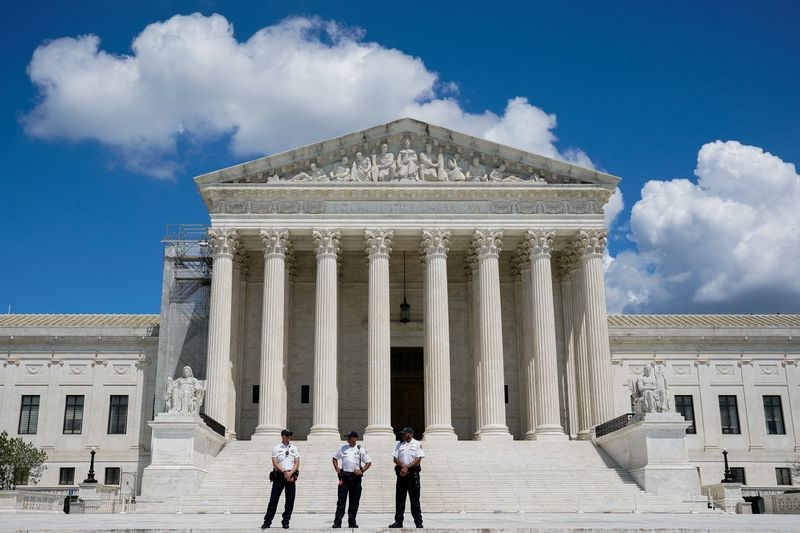
U.S. Supreme Court to consider scope of workplace bias law
U.S. Supreme Court to consider scope of workplace bias law By Reuters
Breaking News
‘;
Published Jun 30, 2023 01:54PM ET
Updated Jun 30, 2023 06:28PM ET
(C) Reuters. FILE PHOTO: Law enforcement officers stand guard outside the U.S. Supreme Court in Washington, U.S., June 24, 2023. REUTERS/Elizabeth Frantz/File Photo
By Daniel Wiessner
(Reuters) – The U.S. Supreme Court on Friday agreed to decide whether workers can bring discrimination lawsuits based on unwanted workplace transfers that were allegedly motivated by bias, an issue that can make or break many cases.
The justices took up a case involving St. Louis police officer Jatonya Muldrow, who is seeking to revive claims that she was transferred to an undesirable post to make way for a male officer. Muldrow appealed a lower court’s ruling that the conduct by the police department could not form the basis of a discrimination lawsuit.
The Supreme Court will hear the case in its next term, which begins in October.
Many of the thousands of discrimination lawsuits filed each year involve workers who allege they were transferred for discriminatory reasons, including as a way to force them to quit their jobs.
President Joe Biden’s administration in May urged the court to take up the issue, saying rulings by lower courts dismissing such litigation misinterpreted federal anti-discrimination laws that only apply to “adverse employment actions” driven by bias.
The Supreme Court on Friday took no action on a separate case questioning whether paid suspensions count as adverse employment actions under Title VII of the Civil Rights Act of 1964.
The lower courts said that to state a claim under Title VII, workers must show that they suffered a material harm or significant change in their employment status such as a firing, demotion or decrease in pay.
Muldrow has said she was transferred out of an intelligence unit by a new supervisor who wanted a man in the position. The department has said officers are routinely transferred and the plaintiff’s supervisor transferred more than 20 officers when he took over the unit.
U.S. Supreme Court to consider scope of workplace bias law
Terms And Conditions
Privacy Policy
Risk Warning
Do not sell my personal information
(C) 2007-2023 Fusion Media Limited. All Rights Reserved.
Risk Disclosure: Trading in financial instruments and/or cryptocurrencies involves high risks including the risk of losing some, or all, of your investment amount, and may not be suitable for all investors. Prices of cryptocurrencies are extremely volatile and may be affected by external factors such as financial, regulatory or political events. Trading on margin increases the financial risks.Before deciding to trade in financial instrument or cryptocurrencies you should be fully informed of the risks and costs associated with trading the financial markets, carefully consider your investment objectives, level of experience, and risk appetite, and seek professional advice where needed.Fusion Media would like to remind you that the data contained in this website is not necessarily real-time nor accurate. The data and prices on the website are not necessarily provided by any market or exchange, but may be provided by market makers, and so prices may not be accurate and may differ from the actual price at any given market, meaning prices are indicative and not appropriate for trading purposes. Fusion Media and any provider of the data contained in this website will not accept liability for any loss or damage as a result of your trading, or your reliance on the information contained within this website.It is prohibited to use, store, reproduce, display, modify, transmit or distribute the data contained in this website without the explicit prior written permission of Fusion Media and/or the data provider. All intellectual property rights are reserved by the providers and/or the exchange providing the data contained in this website.Fusion Media may be compensated by the advertisers that appear on the website, based on your interaction with the advertisements or advertisers.

